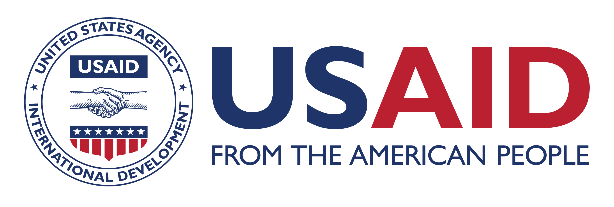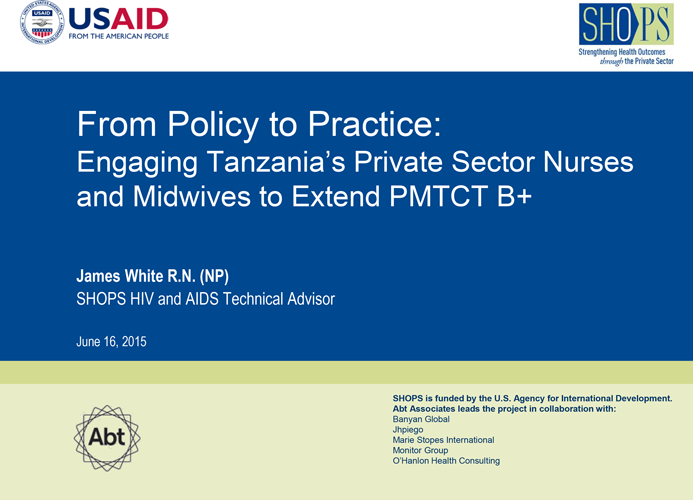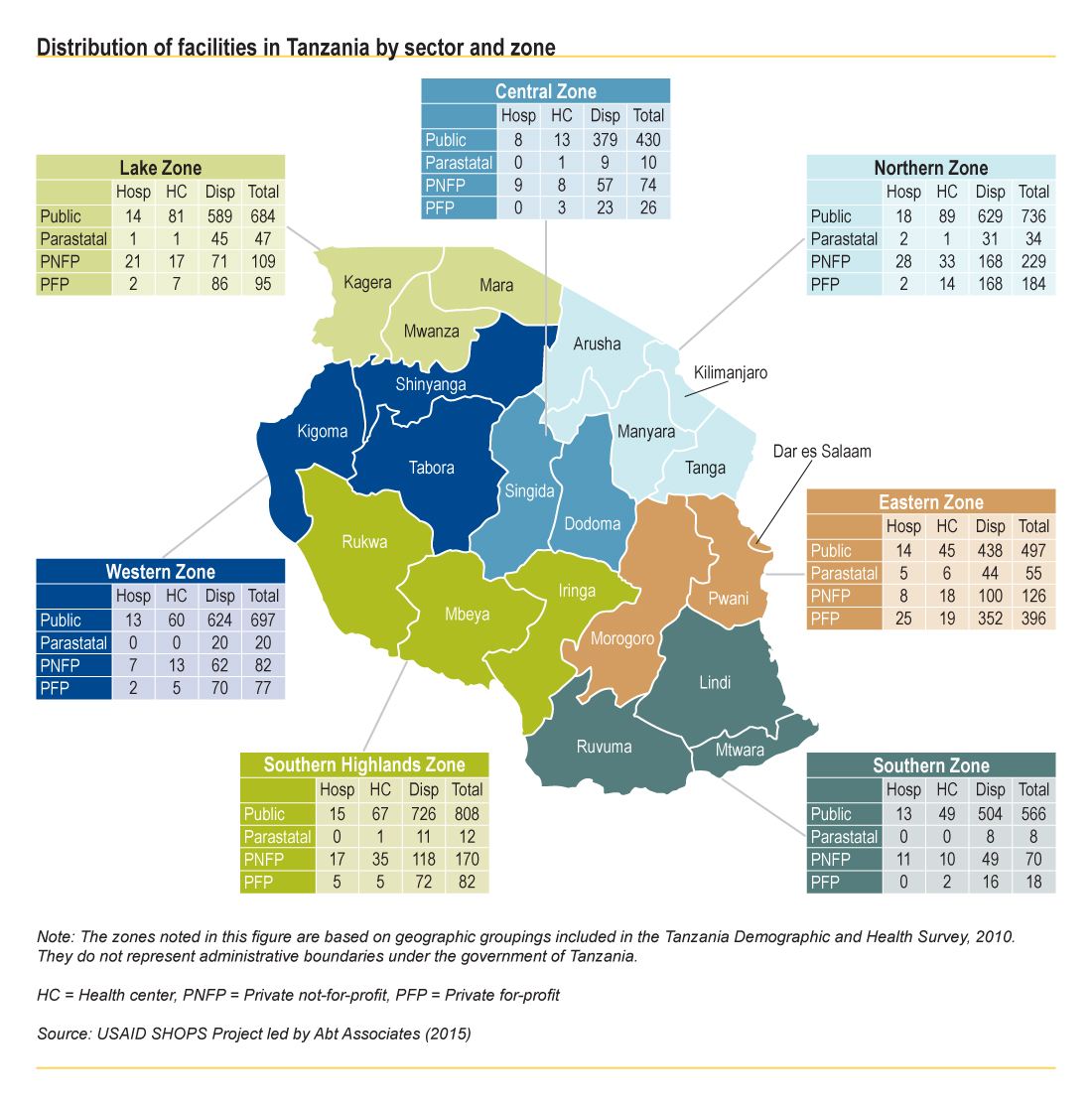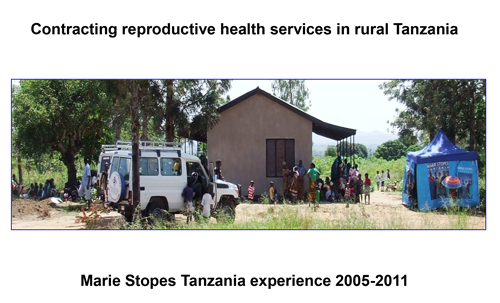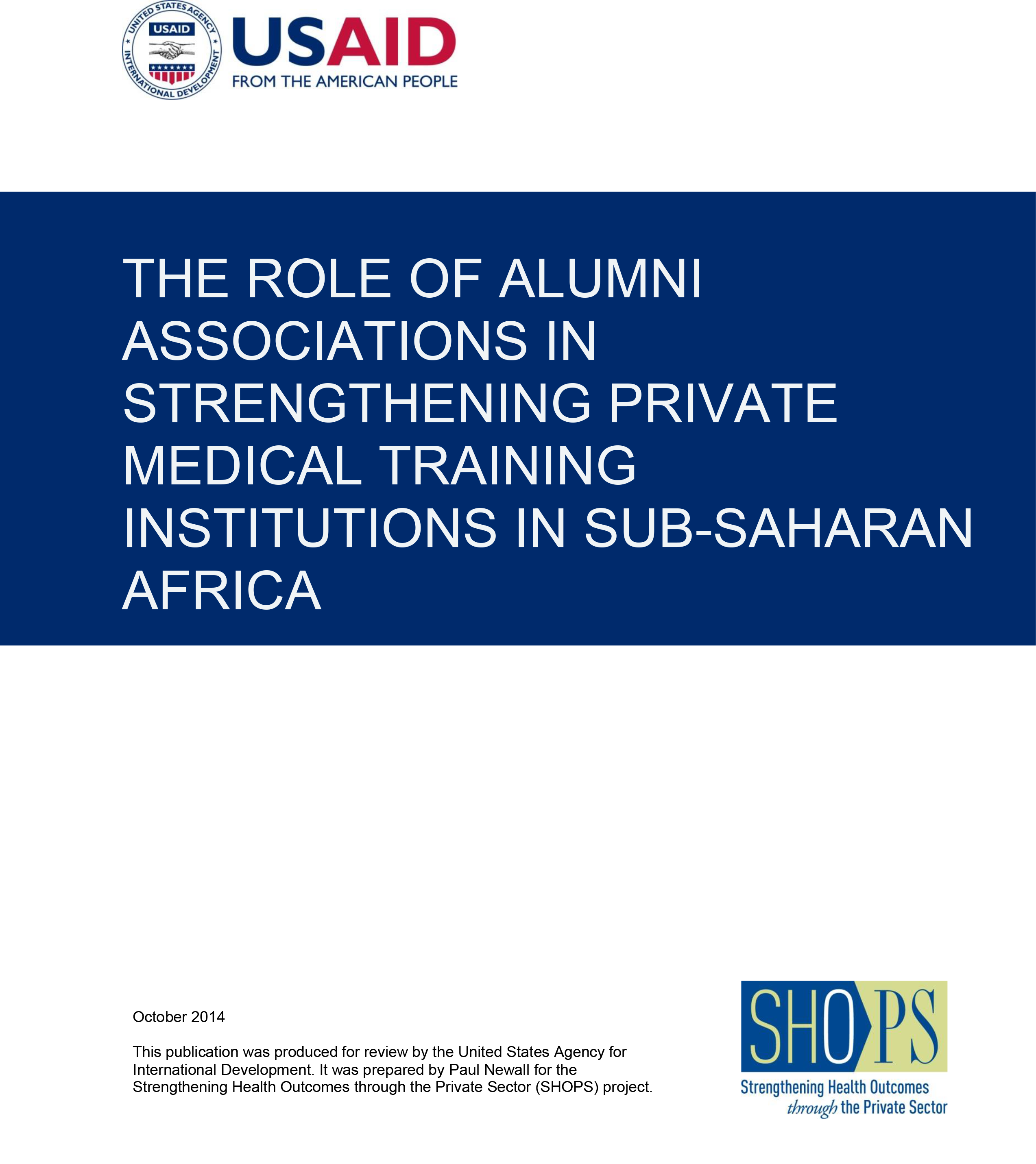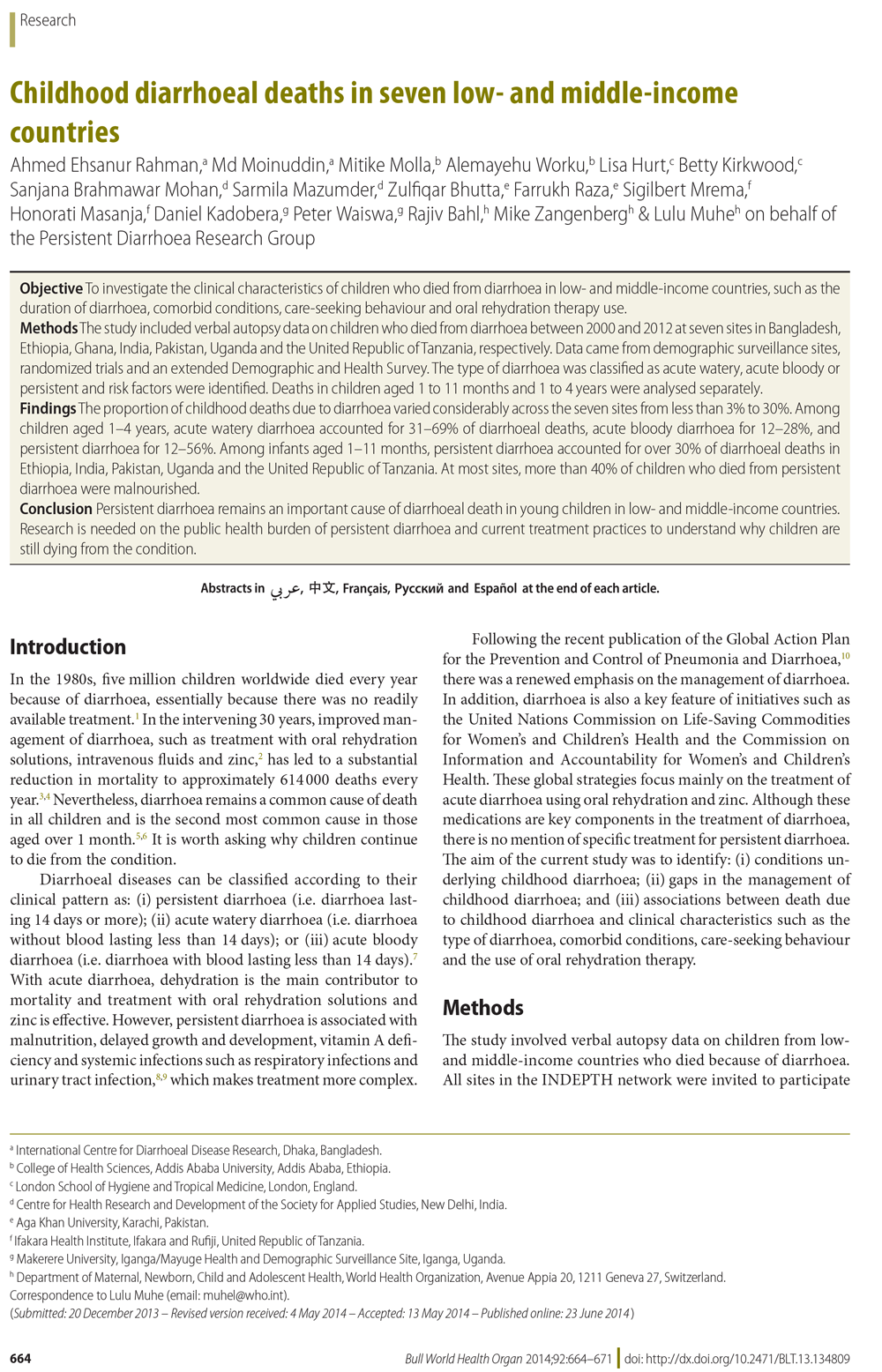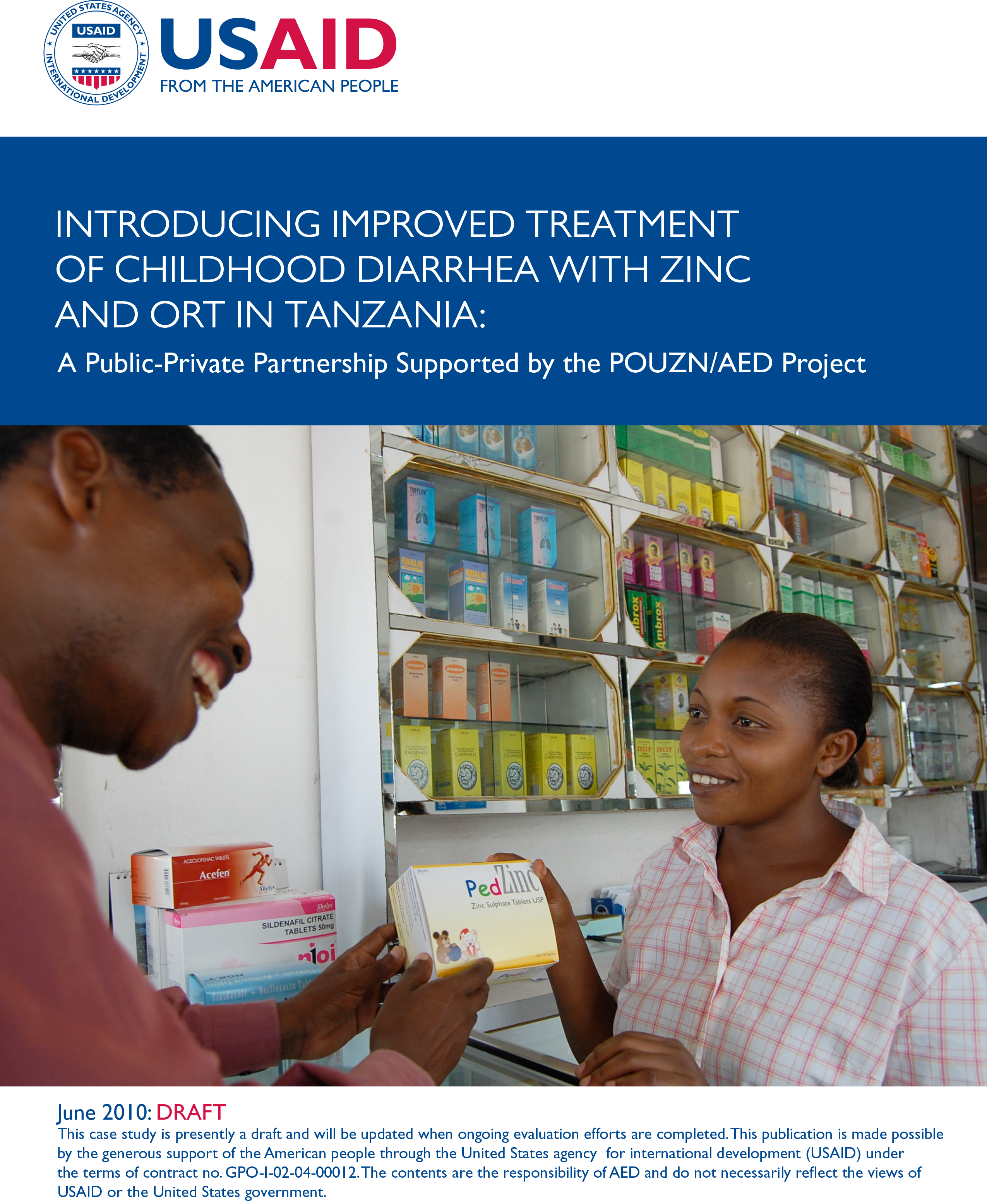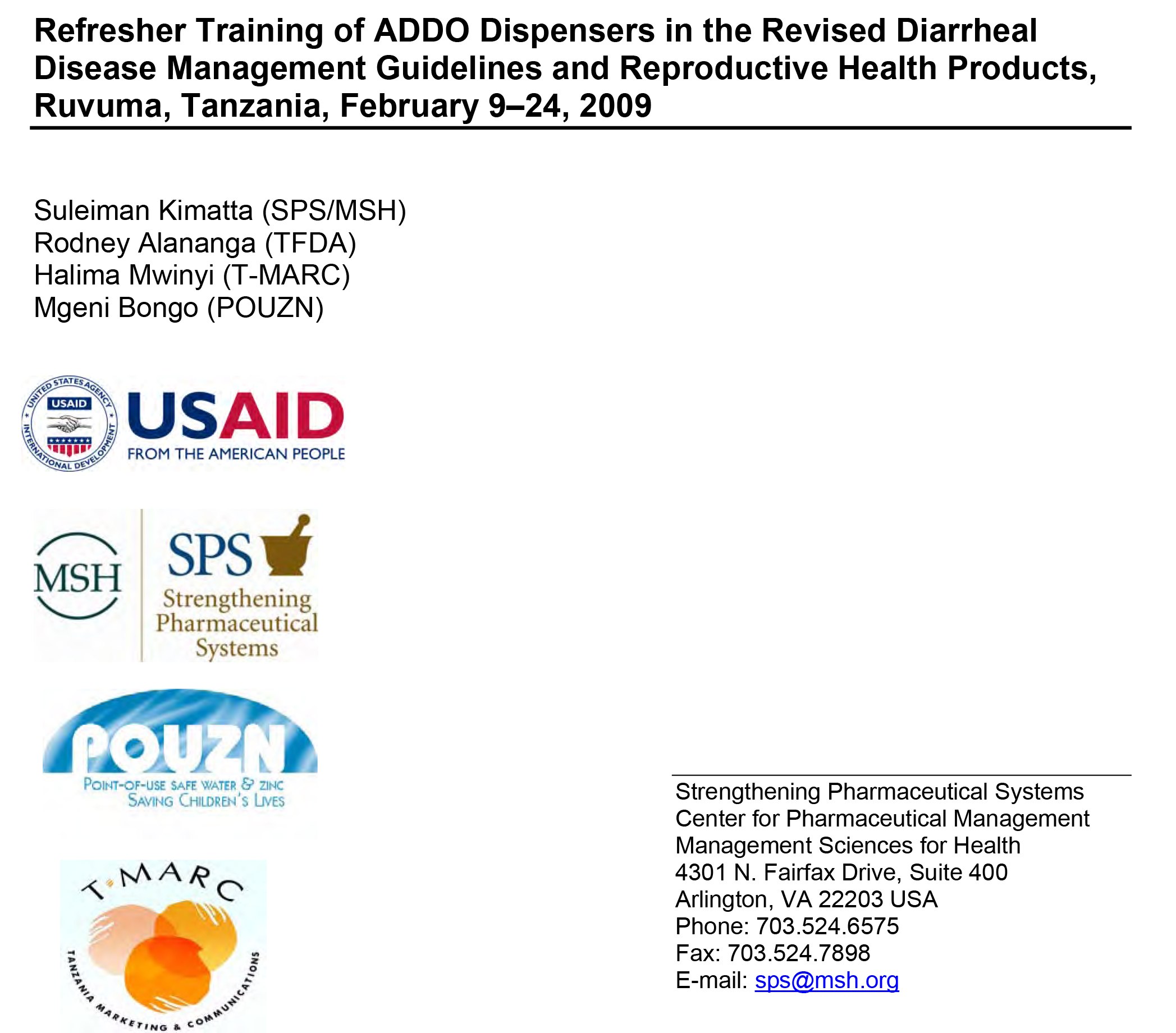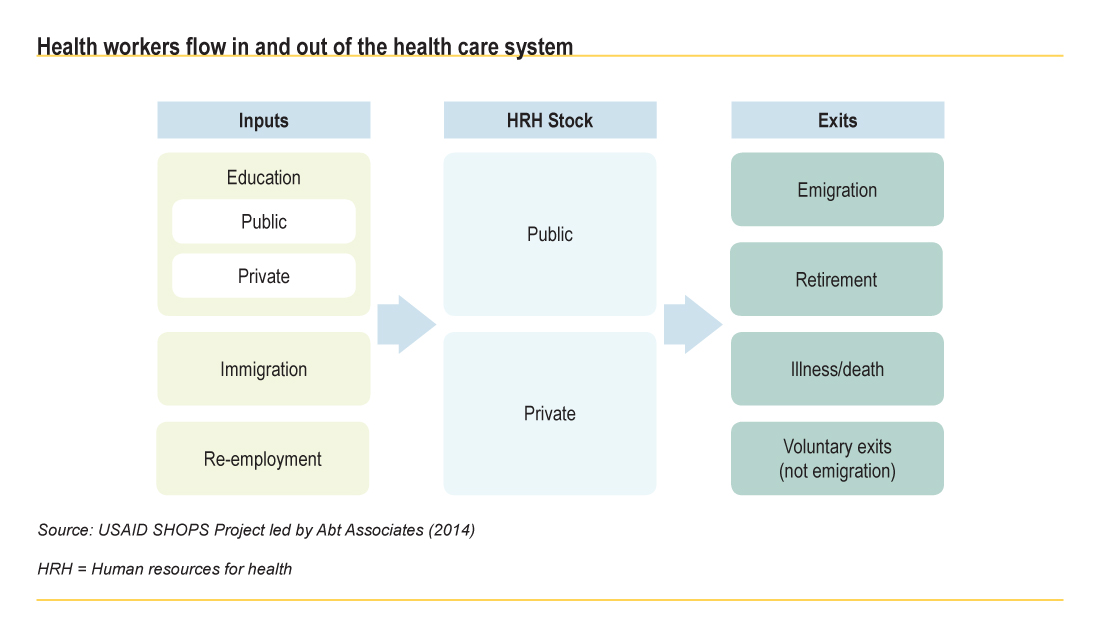
Resource Library
From Policy to Practice: Engaging Tanzania’s Private Sector Nurses and Midwives to Extend PMTCT B+
This presentation examines how SHOPS increased access to HIV testing and counseling, as well as to PMTCT B+, by engaging private sector nurses and midwives in Tanzania. It was presented by James White at the SHOPS end-of-project event on June 16, 2015.
Resource Type : Presentation
Country : Tanzania
Year : 2015-07-06T00:00:00
Language : English
Project : SHOPS

Resource Library
Tanzania Program Profile
The SHOPS project implemented a two-year technical assistance program in Tanzania funded by the United States Agency for International Development from July 2013 to September 2015. The program had three main objectives: (1) improve the policy environment for private sector provision of HIV and AIDS and other essential health services; (2) increase the availability of information on the current and potential role of the private sector in HIV service provision; and (3) build private health sector capacity to deliver and scale up HIV and other essential health services. SHOPS used a multi-sectoral, participatory approach focused on sustainability and country ownership. This profile presents the goals, components, results, and the following lessons learned:
- Gathering and widely disseminating health information is fundamental for developing informed interventions and partnerships.
- District-level public-private partnership fora can facilitate alliances when supported by a neutral broker.
- The private sector is an important source of health services that can be more effectively leveraged through greater involvement in local planning and funding processes.
- National policies and guidelines that formalize task sharing can lead to rapid increases in service coverage and improved patient outcomes.
- Improving HIV and AIDS patient outcomes at the facility level requires both provider capacity-building efforts and targeted health systems strengthening interventions.
Resource Type :
Country : Tanzania
Year : 2015-06-17T00:00:00
Language : English
Project : SHOPS

Resource Library

Advancing Knowledge to Inform Program Design
Minki Chatterji, research director for the SHOPS project, oversees the project’s research portfolio, which includes global research, process and impact evaluations, formative research, provider censuses, and qualitative behavioral research. A demographer by training, she has more than 10 years of experience in global health research, including work on family planning and reproductive health, HIV and AIDS, and maternal and child health. In this video, Chatterji discusses the range of SHOPS research and how the project incorporates its research into its programs.
Resource Type : Video
Country : Bangladesh, Benin, Bolivia, Botswana, Ethiopia, Ghana, Haiti, India, Jamaica, Jordan, Kenya, Madagascar, Malawi, Mali, Namibia, Nepal, Pakistan, Paraguay, Peru, Philippines, Russia, Sénégal, Senegal, South Africa, Tanzania, UAR, Uganda, Zambia, Zimbabwe
Year : 2015-04-15T12:00:00
Language : English
Project : SHOPS

Resource Library
Contracting Reproductive Health Services in Rural Tanzania
This health financing case study describes the contracting model that operated between Marie Stopes Tanzania and 13 Local Government Authorities from 2005 to 2011. The program was envisioned with dual objectives: first, to increase access to comprehensive maternal, newborn, child and HIV/AIDS services in remote areas; and second, to design and implement a public-private partnership model of cooperation between a non0state health provider and decentralized Local Government Authorities. This contracting experience provides an interesting example of how donors can support national governments and non-state actors like MSI to pilot new partnerships for the benefit of the population.
Resource Type : Report
Country : Tanzania
Year : 2011-01-01T00:00:00
Language : English
Project : SHOPS

Resource Library
The Role of Alumni Associations in Strengthening Private Medical Training Institutions in Sub-Saharan Africa
The significant growth in private medical training institutions (PMTIs) throughout sub-Saharan Africa is a response to the demand for medical training and supply shortages. PMTIs can significantly increase the number of health workers needed to address the many health challenges facing sub-Saharan Africa. SHOPS studied strategies used by private, higher education institutions in the United States and elsewhere and helped PMTIs to establish alumni associations using Hubert Kairuki Memorial University in Tanzania as a start-up model. One of the greatest challenges in launching the alumni association was the creation of the alumni database. This challenge was addressed through the identification of committed and influential alumni champions. This study outlines steps that, if correctly implemented, will generate a number of benefits for PMTIs, their students, and alumni. Many of the benefits can serve to strengthen the medical profession in sub-Saharan Africa and contribute to health outcomes across the continent.
Resource Type : Brief
Country : Tanzania
Year : 2014-10-31T00:00:00
Language : English
Project : SHOPS

Resource Library
Childhood diarrheal deaths in seven low-and middle-income countries
The objective of this study was to investigate the clinical characteristics of children who died from diarrhea in low- and middle-income countries, such as the duration of diarrhoea, comorbid conditions, care-seeking behavior and oral rehydration therapy use. The study included verbal autopsy data on children who died from diarrhea between 2000 and 2012 at seven sites in Bangladesh, Ethiopia, Ghana, India, Pakistan, Uganda and the United Republic of Tanzania, respectively. Data came from demographic surveillance sites, randomized trials and an extended Demographic and Health Survey. The type of diarrhea was classified as acute watery, acute bloody or persistent and risk factors were identified. Deaths in children aged 1 to 11 months and 1 to 4 years were analyzed separately. Findings revealed that the proportion of childhood deaths due to diarrhea varied considerably across the seven sites from less than 3% to 30%. Among children aged 1–4 years, acute watery diarrhea accounted for 31–69% of diarrheal deaths, acute bloody diarrhea for 12–28%, and persistent diarrhea for 12–56%. Among infants aged 1–11 months, persistent diarrhea accounted for over 30% of diarrheal deaths in Ethiopia, India, Pakistan, Uganda and the United Republic of Tanzania. At most sites, more than 40% of children who died from persistent diarrhea were malnourished. Persistent diarrhea remains an important cause of diarrheal death in young children in low- and middle-income countries. Research is needed on the public health burden of persistent diarrhea and current treatment practices to understand why children are still dying from the condition.
Resource Type : Brief
Country : Bangladesh, Ethiopia, Ghana, India, Pakistan, Tanzania, Uganda
Year : 2014-06-23T00:00:00
Language : English
Project : SHOPS

Resource Library
Introducing Improved Treatment of Childhood Diarrhea with Zinc and ORT in Tanzania
This case study describes the first four years of POUZN activities in Tanzania. Use of zinc is now increasing across Tanzania, including in rural areas where diarrhea mortality is highest. Nonetheless, challenges remain - particularly in improving caregiver acceptance of zinc treatment and ORT. Many of the lessons learned during the initial five-year project will be useful as stakeholders move forward romoting zinc treatment at scale. The case study covers the introduction of zinc treatment to Tanzania, both in the public and private sectors. Context and goals are discussed, as well as strategies implemented and adjustments made. The project looks to the future for next steps and summarizes lessons learned.
Resource Type : Report
Country : Tanzania
Year : 2010-06-01T00:00:00
Language : English
Project : SHOPS

Resource Library
Refresher Training of ADDO Dispensers in the Revised Diarrheal Disease Management Guidelines and Reproductive Health Products, Ruvuma, Tanzania, February 9-24, 2009
Management Sciences for Health’s SPS Program collaborated with the POUZN Project and TMARC to plan and implement refresher training sessions in the Ruvuma region in Tanzania. The sessions oriented 211 Accredited Drug Dispensing Outlet (ADDO) dispensers, 16 Council Health Management Team members, and 9 cascade supervisors of health zones on the revised diarrheal disease management guidelines, which include zinc treatment, the appropriate use of selected reproductive health products, and the current monitoring and evaluation system for the ADDOs. Follow on visits were made to ADDOs to review appropriate drug dispensing practices.
Resource Type : Brief
Country : Tanzania
Year : 2009-02-24T00:00:00
Language : English
Project : SHOPS

Resource Library
Assessing the performance, practices and roles of drug sellers/dispensers and mothers'/guardians behaviour for common childhood conditions in Kibaha district, Tanzania
In most third world countries, self-medication is common and pharmacies, drug stores and drug shops are important providers of health advice and inexpensive medicines. We used exit interviews to assess drug sellers'/dispensers' roles and consumers' behaviour in Kibaha district, Coast region, Tanzania. Exit interviews with mothers/guardians reported the following childhood conditions treated with or without prescriptions at drug shops: respiratory infections (34%), fever (21%), a combination of diarrhoea, acute respiratory infection (ARI) and fever (14%), diarrhoea alone (13%) and other conditions (17%). The majority of drug sellers/dispensers prescribed or dispensed branded drugs (85%) for most mothers/guardians who visited these drug shops. In addition, antibiotics in total were prescribed for 31% of the mothers/guardians. Of the antibiotics dispensed, 38% were not prescribed by clinicians. In total, oral rehydration salts (ORSs) (3%), antimalarials (sulphadoxine/pyrimethamine) (24%) and antipyretics (11%), were prescribed in 20% but were bought by only 9%; multivitamins (6%), cough mixtures (4%) and other drugs (2%) (antihelminthics, benzylbenzoate emulsions, ear and eye drops) were also purchased from these facilities. Of the diarrhoea case histories presented by simulated clients at the drug shops, only 35% of the bloody diarrhoea scenarios were accurately diagnosed for getting antibiotics as compared with 44% for watery diarrhoea for which the use of antibiotics were wrongly advised (P<0.01). Furthermore, drug sellers/dispensers in these drug shops recommended use of ORS less frequently (3%) for a combination of diarrhoea, ARI and fever, and 2% for ARI alone than for watery (29%) and bloody diarrhoea (32%), respectively, for children under five years of age (P<0.001). Antimicrobial agents were advised for ARI (38%), watery diarrhoea (44%) and bloody diarrhoea (35%), respectively, with no significant difference among the three common childhood conditions. Antipyretics were advised in almost all childhood conditions but were least in watery (2%) and bloody diarrhoea (4%). This study demonstrates that antibiotics are overused in both the urban and rural settings of Kibaha district and that this is due to both clinicians'and drug sellers'prescribing practices in public and private facilities. The use of branded drugs was more common than that of generic drugs in private pharmacies, drug stores and ordinary shops. It is hereby proposed that any intervention should focus on training both facilities in the district on selectively prescribing and rational use of antibiotics for ARI and diarrhoea, and also to prescribe and dispense generic drugs so that it costs patients less when they buy drugs in shops. There is a need to increase awareness in recommending the use of ORS for clients to manage watery and bloody diarrhoea, and ARI in children under five years of age.
Resource Type : Brief
Country : Tanzania
Year : 2007-10-01T00:00:00
Language : English
Project : SHOPS

Resource Library
Financing Medical Education through the Private Sector
From 2010 through 2013, the SHOPS project implemented a series of pilot activities to explore the feasibility of introducing private sector health education financing mechanisms. SHOPS explored private sector solutions to help meet ambitious targets from the U.S. President’s Emergency Plan for AIDS Relief for training new health care workers. This report shares the project’s work with private pre-service education financing in Malawi, Rwanda, Tanzania, and Zambia. The authors capture major lessons from these pilot efforts and provide an evidence-based framework that policymakers and donors can use to improve health education financing.
Resource Type : Report
Country : Malawi, Tanzania, Zambia
Year : 2014-12-05T00:00:00
Language : English
Project : SHOPS
Pagination
- Previous page
- Page 6
- Next page

